Scientific participation in SKA
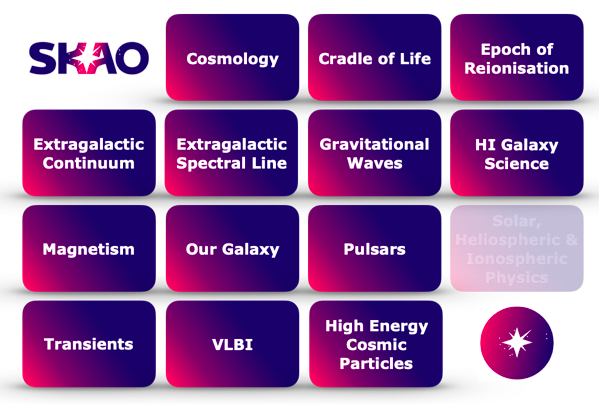
National participation in the SKA Science Working Groups (SWG), advisors to the Observatory.
The interest of the Spanish scientific community in the science that will be possible with the telescopes of the SKA Observatory (SKAO) is reflected in the publication of the Spanish SKA White Book in 2015, the result of a coordinated effort by 119 Spanish astronomers from 25 Spanish and 15 international research centres. These contributions were organised in a total of 30 chapters, covering a wide range of SKA science drivers: cosmology and large-scale structure in the universe, galaxy evolution, magnetism in the universe, the cradle of life and its chemistry, stellar astrophysics, SKA precursors and synergies with other facilities. The unprecedented sensitivity of SKA will bring unique information to fundamental questions such as: How do galaxies evolve and what is dark energy? Was Einstein right about gravity? Are we alone in the universe? Which are the first seeds of galaxy formation?
Many research projects carried out by Spanish astronomers are tightly aligned with the SKAO science objectives. Consequently, there is Spanish participation in 13 of the 14 SKA Scientific Working Groups (SWG). Furthermore, researchers from Spanish institutions participated in 14 of the 135 chapters of the international book «Advancing Astrophysics with the Square Kilometre Array» (2015), leading three of them. All this highlights the potential for a first-line scientific exploitation of the SKA by the Spanish scientific community.
The SKA early science, with SKA-Mid and SKA-Low telescopes, is planned for 2027. This means that recent scientific work is being carried out with data from the precursor telescopes (MeerKAT, ASKAP, MWA and HERA - telescopes physically located at the same sites as the SKA telescopes) and pathfinders (Apertif, Arecibo, ATA, CHIME, eEVN, Effelsberg, EMBRACE, eMERLIN, eVLA, FAST, GMRT, LOFAR, Parkes, LWA, NenuFAR, SKAMP and VERA - systems around the world involved in SKA-related science and technology studies) of SKA. Below is a list of the latest scientific published papers, with authors or co-authors from Spanish institutions, published that used data from SKA precursor telescopes in their research:
- MIGHTEE-HI: HI galaxy properties in the large-scale structure environment at z 0.37 from a stacking experiment. Sinigaglia, F. et al. (2024)
- Testing EMRI Models for Quasi-periodic Eruptions with 3.5 yr of Monitoring eRO-QPE1. Chakraborty, J. et al. (2024)
- Gamma-ray detection of newly discovered Ancora supernova remnant: G288.8-6.3 Burger-Scheidlin, C. et al. (2024)
- WALLABY pilot survey: an ‘almost’ dark cloud near the Hydra cluster. O’Beirne, T. et al. (2024)
- FAST-ASKAP Synergy: Quantifying Coexistent Tidal and Ram Pressure Strippings in the NGC 4636 Group. Lin, X. et al. (2023)
- Probing magnetic fields in the circumgalactic medium using polarization data from MIGHTEE. Böckmann, K. et al. (2023)
- The Rapid ASKAP Continuum Survey III: Spectra and Polarisation In Cutouts of Extragalactic Sources (SPICE-RACS) first data release. Thomson, A. J. M. et al. (2023)
- NGC 1436: the making of a lenticular galaxy in the Fornax Cluster. Loni, A et al. (2023)
- MIGHTEE-HI: possible interactions with the galaxy NGC 895. Namumba, B. et al. (2023)
On the other hand, the SKAO has already published on its website the first versions of the SKA-Low and SKA-Mid sensitivity calculators. These include, for now, the spectral and continuum calculations (including zoom modes).
Selection of SKA Precursors and Pathfinders images with the participation of researchers from Spanish centres.
Click on the images to see them full size.
-
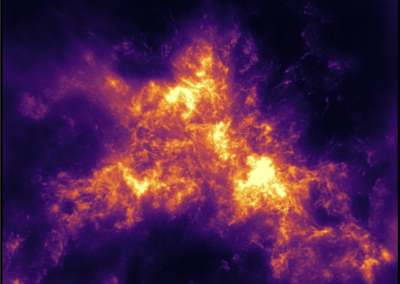
Combined image cube from both ASKAP interferometer and Parkes antenna of the Small Magellanic Cloud, showing small-scale structures throughout the overall smooth diffuse HI component. Credits: Pingel et al. 2022.
-
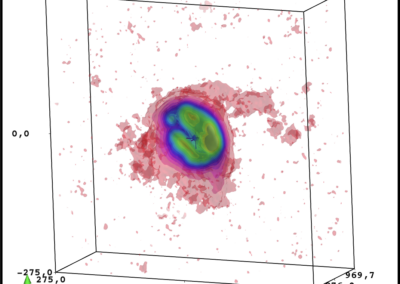
Atomic hydrogen emission associated with the galaxy ESO 302-G014 as observed with MeerKAT, and represented in three dimensions (two spatial and one velocity), which could indicate a minor interaction with a low-mass galaxy. Credit: de Blok et al. 2020.
-
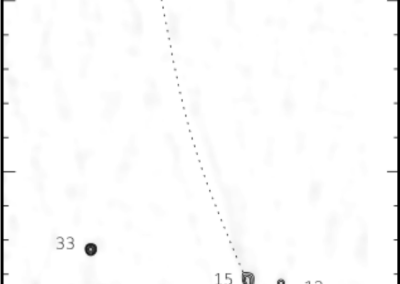
JVLA map at 6 cm band of the HH 80/81/80N jet and radio-knots emanating from a high-mass protostar. Credits: Masqué et al. 2015.
-
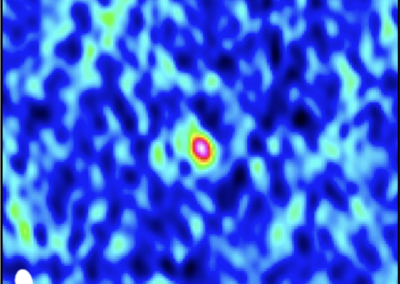
33 GHz radio emission from the nearby ultracool dwarf binary substellar system VHS 1256−1257 AB. Credits: Climent et al. 2022.
-

Detailed VLA image of the 8000 light-years long jet in the galaxy M87. These observations resolve a double helix structure in the inner part of the jet, supporting the presence of a helical magnetic field up to 1 kpc from the central black hole. Credits: Pasetto et al. 2021, S. Dagnello, NRAO/AUI/NSF.
-

Optical images obtained with the Subaru telescope of each member galaxy of a group discovered with MeerKAT. The red outline indicates the extent of neutral hydrogen around each galaxy. Credit: S. Ranchod et al. 2022 / Project MIGHTEE / HSC.
-
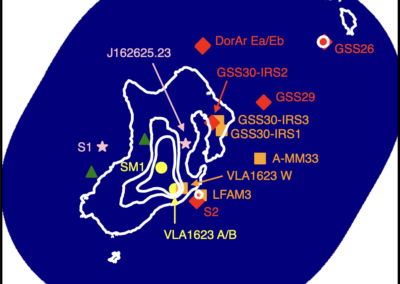
VLA X band observations (in blue) of the nearby star-forming region Ophiuchus A. Different young stellar objects detected are indicated (yellow circles, orange squares, red diamonds, and pink stars, according to their class). Credits: Coutens et al. 2019.
-
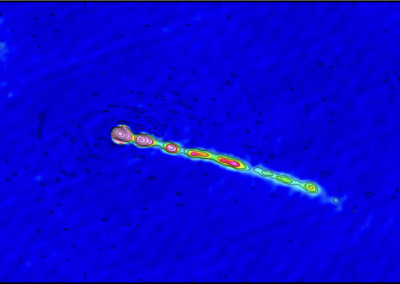
LOFAR (contour levels) and VLA (background image) observations of the radio jets from the powerful supermassive black hole in the quasar 4C+19.44, showing the presence of several knots along the jet. Credits: Harris et al. 2019.
-
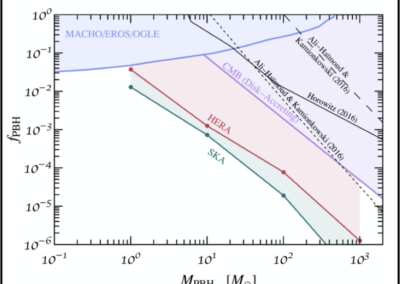
Estimated 2σ sensitivity of SKA and HERA interferometer for a monochromatic distribution of primordial black holes in comparison to various limits derived from other surveys. Credits: Mena et al. 2019.
-
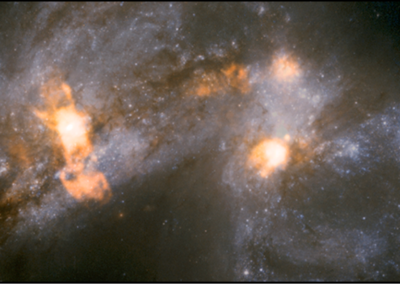
Optical image of the nearby system Arp 299, consisting of a merger of two galaxies, combined with the first sub-arcsecond radio imaging with the SKA pathfinder LOFAR (in orange). The LOFAR data included in the image reveal a galaxy-sized wind emerging from a hidden star factory in the nucleus. Credits: N. Ramírez-Olivencia et al. ; NASA, ESA, the Hubble Heritage Team (STScI/AURA)-ESA/Hubble Collaboration and A. Evans (Univ. of Virginia, Charlottesville/NRAO/Stony Brook University), edited by R. Cumming.

